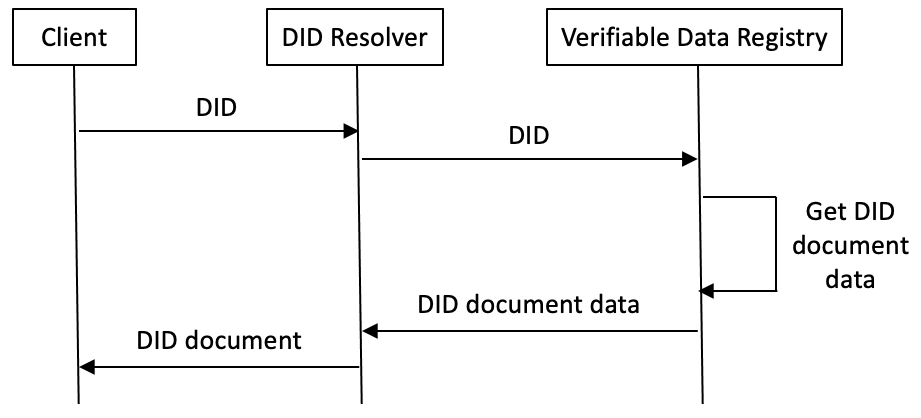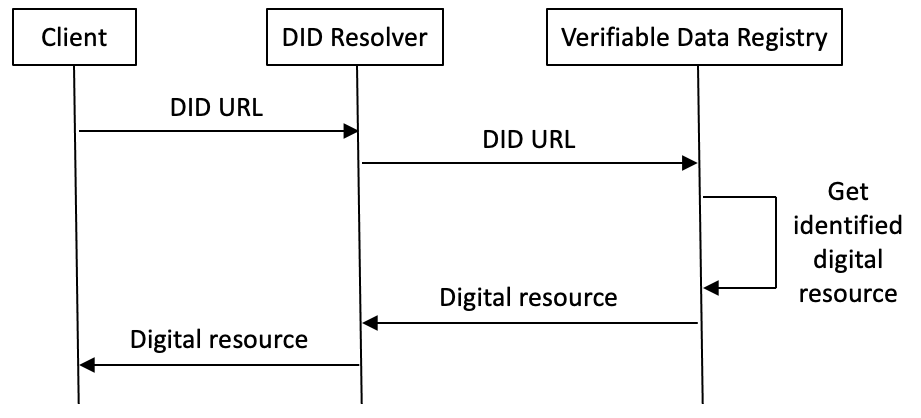THIS SPECIFICATION IS BEING SUPERSEDED by the DID-Linked Resources Specification hosted by the Utility Foundry Working Group — please see that specification for all future work.
This document is a Draft Deliverable of the ToIP Technical Stack Working Group.
The current version is Working Draft 03.
This is a specification for an extension to the W3C Decentralized Identifiers (DIDs) 1.0 specification to support the resource parameter as listed in the W3C DID Specification Registries 1.0. It specifies the syntax and normative behavior for usage of the parameter and the requirements for DID methods that support the parameter.
In this document, the key words "MUST", "MUST NOT", "REQUIRED", "SHALL", "SHALL NOT", "SHOULD", "SHOULD NOT", "RECOMMENDED", "MAY", and "OPTIONAL", when appearing in ALL CAPITALS, are to be interpreted as described in RFC 2119.
All other terms are linked to their definitions in the W3C Decentralized Identifiers (DIDs) 1.0 specification.
The purpose of this specification is to specify how a DID URL may include a parameter that instructs a DID resolver to request the associated verifiable data registry (VDR) to directly return a digital resource identified by a decentralized identifier (DID). This parameter is only available for DID URLs whose DID method supports the parameter. The parameter also supports requesting the resource in a particular media type.
The process of resolving a DID and dereferencing a DID URL (meaning a DID that includes an additional path, query, and/or fragment component as defined by the ABNF in section 3.2 of the DID 1.0 specification) is shown in figure 1 from section 7.2 of the spec:
Figure 1: The relationship of DIDs, DID URLs, DID documents, and Resources
The normal pattern for processing a DID URL consists of two steps:
The first of these two steps—the DID resolution step—is shown in figure 2.

Figure 2: The normal DID resolution process
For a DID URL, the return of the DID document to the resolver commences the second step of dereferencing the identified resource based on the portion of the DID URL that follows the DID. An example is processing a DID fragment to return a specific public key from the DID document. How dereferencing operates depends on the DID URL and the DID method.
However an exception to this normal 2-step resolution/dereferencing process is when the DID itself identifies a digital resource that can be returned directly by the VDR of the associated DID method. This behavior may be desirable:
In this case, the client MAY wish to use a DID URL to request that a DID resolver return the identified digital resource in a single step as shown in Figure 3:

Figure 3: Using a DID URL to request a digital resource in a single step
Two important notes about this process:
resource parameter conformant with this specification. The VDR then follows the specification of the associated DID method to retrieve the identified digital resource and return that resource to the resolver directly.resource parameter serves a different purpose than the alsoKnownAs parameter. The purpose of the alsoKnownAs parameter is to map a DID to an alternative identifier for the same DID subject. This alternative identifier can be any other URI, e.g., a URL, or a URN, or another DID. When the DID is resolved, the value of the alsoKnownAs parameter is returned as a property of the DID document. It is then up to the client to decide what action to take with this alternative identifier. For example, if the value is a URL, the client may choose to dereference this URL to retrieve the identified Web resource. In this case, the the alsoKnownAs parameter essentially serves as a redirection mechanism managed by the DID controller. By contrast, the resource parameter:alsoKnownAs parameter if desired.)resource parameter is to enable a DID URL to resolve directly to the digital resource—including the ability to specify the requested media type of the resource—so that developers are completely abstracted from the mechanics of how the VDR actually returns the identified resource to the requesting DID resolver.To enable this combined resolution/dereferencing behavior, this specification defines a DID URL parameter named resource. If a DID method specification supports this parameter, and if a DID URL using that method includes the parameter with a valid value (either true or a valid media type name), then when a resolver calls the associated VDR using that DID URL, the VDR returns the identified digital resource, not the DID document.
IMPORTANT: A DID URL that includes the resource parameter does still have an associated DID document like any other DID. However if the DID URL includes the resource parameter, the associated DID document is not involved in the combined resolution/dereferencing step. If the DID alone is resolved (without the resource parameter), it will still return the associated DID document. There is nothing special about this DID document. It still describes and controls interactions with the identified digital resource just like any other DID document. For example:
id property (whose value must be the DID) and no verification methods, then the DID document cannot be updated and the identified digital resource is a static resource that cannot be versioned.If the DID document contains one or more alsoKnownAs property values, those values still identify other instances of the identified digital resource available via other URIs, URLs, or DIDs. (See also the recommendation below to include an alsoKnownAs property whose value is a hashlink to the identified digital resource.)
The parameter name MUST be resource. The parameter value MUST be one of the following:
true. The parameter value of true MUST be case-sensitive and MUST be spelled out exactly. No other renderings of true, i.e. T, TRUE, 1, -1, and so forth — are equivalent.Following are examples of DID URLs that use the resource parameter but do not include a path component. These examples are based on the fictional did:example: DID method that supports the resource parameter:
did:example:21tDAKCERh95uGgKbJNHYp?resource=true
did:example:21tDAKCERh95uGgKbJNHYp?resource=json
did:example:21tDAKCERh95uGgKbJNHYp?resource=ld+json
did:example:21tDAKCERh95uGgKbJNHYp?resource=cbor
The next set of examples are DID URLs that use the resource parameter and include a path component. In this case the target resource identified by the path component is relative to the resource identified by the DID itself. This pattern supports the ability of a VDR to organize digital resources in structures such as directory trees, collections, databases, and so on.
did:example:21tDAKCERh95uGgKbJNHYp/some/path?resource=true
did:example:21tDAKCERh95uGgKbJNHYp/some/longer/path?resource=json
did:example:21tDAKCERh95uGgKbJNHYp/uuid:33ad7beb-1abc-4a26-b892-466df4379a51/?resource=ld+json
did:example:21tDAKCERh95uGgKbJNHYp/resources/uuid:33ad7beb-1abc-4a26-b892-466df4379a51/?resource=cbor
resource parameter with a value of true, a conforming DID resolver MUST return the default media type of the digital resource identified by the DID from the VDR specified by the associated DID method provided such resource is available. Resource not found".resource parameter with a value of a valid media type name, a conforming DID resolver MUST return the requested media type of the digital resource identified by the DID from the VDR specified by the associated DID method provided such resource is available. Resource not found".resource parameter with a value of false, a conforming DID resolver SHOULD ignore the parameter.resource parameter, it MUST return the authoritative DID document as defined in W3C Decentralized Identifiers (DIDs) 1.0. This specification adds no additional requirements to a conforming DID document.A DID method specification conforming to this specification to include support for the resource parameter:
resource parameter has a value of true, how the VDR shall determine the default media type.versionId parameter is included in the DID URL, the resolver MUST return the identified version of the identified digital resource.Version not found".versionTime parameter is included in the DID URL, the resolver MUST return the identified version of the identified digital resource.Version not found".alsoKnownAs property containing at least one value that is a hashlink to the identified digital resource. This provides additional cryptographic verification of the binding between the DID and the identified digital resource.resource parameter. A much better solution is to store the mapping between the DID and the identified digital resource within the VDR itself (and specify how this works in the DID method specification). This way the VDR can evolve its internal storage mechanisms without requiring DID controllers to make any changes to their DID documents.The resource parameter defined by this specification is registered with the W3C DID Specification Registries 1.0 at the following URL:
https://www.w3.org/TR/did-spec-registries/#resource
To comply with the intellectual property rights protections in the charter of the ToIP Foundation (as required by all Joint Development Foundation projects hosted the Linux Foundation), all contributors to this Pre-Draft Deliverable MUST be current members of the ToIP Foundation. The following contributors each certify that they meet this requirement:
The authors wish to thank the editors and contributors to the W3C Decentralized Identifiers (DIDs) 1.0 specification and in particular co-editor Amy Guy for her help. Also thanks to the cheqd team of Ankur Banerjee and Alex Tweeddale for their suggestions about including support for the DID path component.
This is a publicly available specification published by the ToIP Foundation under the following licenses: